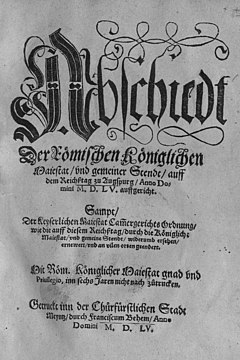Treaty of Augsburg

The front page of the document. Mainz, 1555.
|
|
| Date | 1555 |
|---|---|
| Location | Augsburg |
| Participants | Charles V; Schmalkaldic League |
| Outcome | (1) Established the principle Cuius regio, eius religio. (2) Established the principle of reservatum ecclesiasticum. (3) Laid the legal groundwork for two co-existing religious confessions (Catholicism and Lutheranism) in the German-speaking states of the Holy Roman Empire. |
The Peace of Augsburg, also called the Augsburg Settlement, was a treaty between Charles V, Holy Roman Emperor (the predecessor of Ferdinand I) and the Schmalkaldic League, signed in September 1555 at the imperial city of Augsburg. It officially ended the religious struggle between the two groups and made the legal division of Christendom permanent within the Holy Roman Empire, allowing rulers to choose either Lutheranism or Roman Catholicism as the official confession of their state. Calvinism was not allowed until the Peace of Westphalia.
The Peace established the principle Cuius regio, eius religio ("whose realm, his religion"), which allowed the princes of states within the Holy Roman Empire to adopt either Lutheranism or Catholicism within the domains they controlled, ultimately reaffirming their sovereignty over those domains. Subjects, citizens, or residents who did not wish to conform to the prince's choice were given a grace period in which they were free to emigrate to different regions in which their desired religion had been accepted.
Article 24 stated: "In case our subjects, whether belonging to the old religion or the Augsburg Confession, should intend leaving their homes with their wives and children in order to settle in another, they shall be hindered neither in the sale of their estates after due payment of the local taxes nor injured in their honour."
Charles V had made an interim ruling, the Augsburg Interim of 1548, on the legitimacy of two religious creeds in the empire, and this was codified in law on 30 June 1548 upon the insistence of Charles V, who wanted to work out religious differences under the auspices of a general council of the Catholic Church. The Interim largely reflected principles of religious behavior in its 26 articles, although it allowed for marriage of the clergy, and the giving of both bread and wine to the laity. This led to resistance by the Protestant territories, who proclaimed their own Interim at Leipzig the following year.
...
Wikipedia
